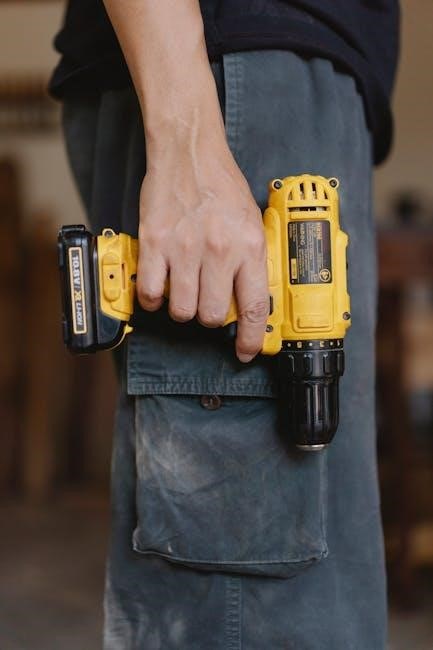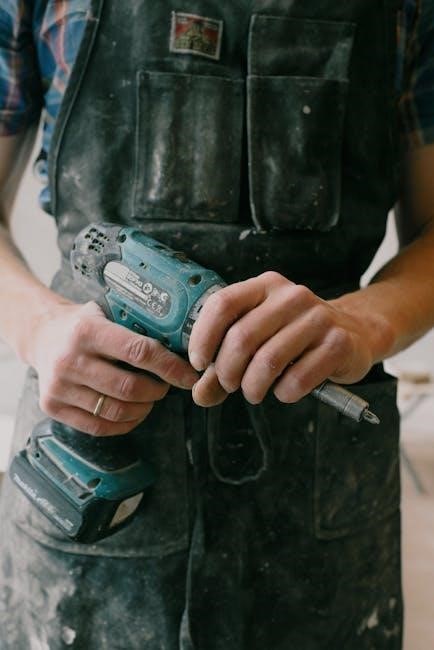Welcome to the Honeywell 3000 Manual, your comprehensive guide to understanding and operating Honeywell’s innovative solutions. This manual provides essential information for safe installation, configuration, and troubleshooting, ensuring optimal performance and energy efficiency for your system.
1.1 Overview of the Honeywell 3000 Series
The Honeywell 3000 Series offers a range of advanced solutions, including the TH3110D and TH3210D models, designed for 1 Heat/1 Cool and 2 Heat/1 Cool systems, respectively. These models provide intuitive temperature control and energy efficiency. Additionally, the Series 3000 MkIII gas detector is engineered for hazardous areas, ensuring safety and reliability. This series is known for its robust design, user-friendly interface, and compatibility with various systems, making it a trusted choice for both residential and industrial applications. The manual provides detailed guidance for installation, configuration, and troubleshooting, ensuring optimal performance and safety.
1.2 Importance of the Manual for Users
The Honeywell 3000 manual is essential for users to understand system capabilities, ensuring safe and efficient operation. It provides detailed instructions for installation, configuration, and troubleshooting, helping users avoid common errors. Compliance with safety standards and optimal performance rely on following the guidelines. Whether for residential or industrial use, the manual empowers users to maximize functionality while maintaining safety. Regular reference to the manual ensures longevity and reliability of the Honeywell 3000 system.

Honeywell 3000 Models and Variants
The Honeywell 3000 series includes multiple models tailored for different applications, offering advanced features and compatibility for residential and industrial use, ensuring versatile functionality.
2.1 TH3110D Model Specifications
The TH3110D model is a high-performance programmable thermostat designed for precise temperature control. It features a backlit LCD display, 7-day programmability, and compatibility with HVAC systems. This model supports geothermal and heat pump systems, offering advanced energy-saving capabilities. The TH3110D includes smart recovery and adaptive learning technologies, ensuring efficient heating and cooling. It also supports remote sensors for enhanced accuracy and is Energy Star certified, making it a reliable choice for modern homes.
- Display: Backlit LCD
- Programmability: 7-day
- Compatibility: HVAC, geothermal, heat pumps
- Smart Features: Smart recovery, adaptive learning
- Certifications: Energy Star
2.2 TH3210D Model Specifications
The TH3210D is an advanced touchscreen thermostat offering enhanced functionality. It features a high-resolution color display, Wi-Fi connectivity, and voice control compatibility. This model supports multi-stage heating and cooling systems, including dual fuel setups. The TH3210D is Energy Star certified, ensuring energy efficiency. It also offers smart home integration, geofencing, and energy usage reporting. The thermostat is compatible with Honeywell’s Home app for remote monitoring and control, making it a versatile choice for modern smart homes. Precise temperature control and adaptive learning capabilities further enhance its performance.
- Display: High-resolution color touchscreen
- Connectivity: Wi-Fi, voice control
- System Support: Multi-stage, dual fuel
- Smart Features: Geofencing, energy reporting
- Compatibility: Honeywell Home app
2.3 Series 3000 MkIII Gas Detector
The Honeywell 3000 MkIII Gas Detector is a reliable solution for detecting hazardous gases in industrial environments. It features advanced sensing technology, real-time monitoring, and audible/visual alarms for safety. The detector is designed for durability, with a robust housing and resistance to harsh conditions. It supports multiple gas types, including flammable and toxic gases. The MkIII model also offers data logging and remote monitoring capabilities for enhanced safety and compliance with industry standards.
- Detects flammable and toxic gases
- Advanced sensing technology
- Durable, weather-resistant design
- Data logging and remote monitoring
- Compliance with safety regulations

Installation Guide for Honeywell 3000
Ensure proper installation by following the manual’s guidelines. Verify site preparation, safety precautions, and required tools. The manual provides step-by-step instructions for a smooth setup process.
- Follow safety protocols
- Use recommended tools
- Adhere to installation guidelines
3.1 Pre-Installation Requirements
Before installing the Honeywell 3000, ensure the site meets all safety and compatibility standards. Review the manual thoroughly to understand system requirements. Verify power supply, wiring, and compatibility with existing systems. Gather all necessary tools and materials as specified. Ensure the area is safe, well-ventilated, and free from hazards. Check for any local regulations or compliance requirements. Proper preparation ensures a smooth and safe installation process.
- Review manual for system requirements
- Ensure power supply and wiring compatibility
- Gather necessary tools and materials
- Ensure a safe and well-prepared site
3.2 Step-by-Step Installation Process
Begin by powering off the system and ensuring all connections are safe. Mount the wallplate securely, following the provided template. Connect the wires according to the manual’s wiring diagram. Install the thermostat unit onto the wallplate, ensuring it clicks into place. Restore power and test the system to confirm proper operation; Refer to the manual for specific configuration steps post-installation. Ensure all connections are secure and double-check wiring for accuracy.
- Power off the system before starting
- Mount the wallplate using the template
- Connect wires according to the diagram
- Install the thermostat and test functionality
3.3 Wallplate Installation and Mounting
Begin by removing the existing thermostat and marking the wall for the new wallplate using the provided template. Ensure the wall is clean and dry. Peel the adhesive backing and press the wallplate firmly into place. Use screws to secure it, if required. Verify the wallplate is level and plumb. Avoid over-tightening to prevent damage. Once mounted, proceed to install the Honeywell 3000 thermostat unit onto the wallplate.
- Mark the wall using the template
- Peel and press the wallplate into place
- Secure with screws if necessary
- Ensure the wallplate is level

Configuration and Setup
Configure the Honeywell 3000 by accessing the menu, setting time, and adjusting system parameters. Use the touchscreen or buttons to navigate and customize settings.
- Navigate through the menu system
- Set time and date
- Adjust temperature and system settings
4.1 Initial Configuration Steps
Start by powering on the Honeywell 3000 and navigating to the main menu. Select “Configuration” to begin setup. Enter the system password if prompted. Set the date, time, and location. Choose the desired operation mode (e.g., heating, cooling, or auto). Enable or disable features like geofencing or smart recovery. Save your settings to complete the initial configuration. Ensure all sensors are recognized and connected properly for optimal performance.
- Power on the device
- Navigate to the configuration menu
- Set date, time, and location
- Select operation mode
- Enable or disable additional features
4.2 Sensor Wiring and Connections
Proper sensor wiring ensures accurate readings and reliable performance. Use the appropriate wire gauge for connections. Connect sensors to designated terminals, ensuring secure fastening. Power off the system before wiring to avoid damage. Verify sensor compatibility with the Honeywell 3000. Follow the wiring diagram for correct polarity and connections. Test all sensors post-installation to confirm functionality. Regularly inspect connections for wear or damage to maintain system integrity.
- Use correct wire gauge
- Connect sensors to designated terminals
- Ensure secure and proper fastening
- Verify sensor compatibility
- Follow wiring diagram for polarity
- Test sensors post-installation
- Inspect connections regularly
4.3 Setting Up Temperature Units and Output Range
Configure temperature units to match your preference by selecting Celsius or Fahrenheit in the system menu. Adjust the output range to align with your HVAC system’s requirements. Ensure accurate temperature control by calibrating the range according to the manufacturer’s guidelines. Proper setup ensures optimal performance and energy efficiency. Refer to the user interface for step-by-step calibration instructions. Verify settings post-configuration to confirm accuracy.
- Select temperature unit (Celsius/Fahrenheit)
- Adjust output range for HVAC compatibility
- Calibrate according to guidelines
- Verify settings for accuracy

Features of the Honeywell 3000
The Honeywell 3000 features a high-resolution touchscreen, remote access capabilities, voice control compatibility, smart learning algorithms, and seamless integration with smart home systems for enhanced functionality.
5.1 Smart Thermostat Features
The Honeywell 3000 boasts advanced smart thermostat features, including geofencing, smart scheduling, and voice control compatibility with smart speakers. It offers energy usage reports, remote access via the Honeywell Home app, and adaptive learning technology to optimize heating and cooling based on user preferences and routines. The thermostat also supports multi-stage heating and cooling systems, ensuring efficient and precise temperature control for enhanced comfort and energy savings.
5.2 Energy Efficiency and Control Options
The Honeywell 3000 offers advanced energy-saving features, including smart scheduling and learning algorithms that adapt to your routine. It provides customizable temperature ranges to prevent excessive heating or cooling. Occupancy sensors ensure energy isn’t wasted in empty spaces. Additionally, energy usage reports help you track and optimize consumption. The system also supports demand response programs, allowing you to manage energy use during peak times for greater efficiency and cost savings.
5.3 Compatibility with Home Automation Systems
The Honeywell 3000 seamlessly integrates with popular home automation platforms, such as Samsung SmartThings and Apple HomeKit. It supports voice control via Amazon Alexa and Google Assistant, enabling easy temperature adjustments. The system also works with smart hubs, allowing centralized control of multiple devices. Remote monitoring and adjustments through smartphone apps enhance convenience. This compatibility ensures a unified smart home experience, optimizing comfort and energy efficiency effortlessly.

Safety Considerations
Ensure safe operation by following hazardous area classifications and compliance standards. Regular inspections and adherence to guidelines prevent accidents, while emergency shutdowns provide failsafe protection.
6.1 Hazardous Area Classifications
Hazardous area classifications define zones based on flammable substances’ presence. The Honeywell 3000 operates in Class I, II, and III environments, adhering to NEC and IEC standards. Proper installation by certified technicians ensures safety and prevents ignition risks, maintaining compliance and reliability in hazardous settings.
6.2 Compliance with Safety Standards
The Honeywell 3000 complies with global safety standards, including NEC and IEC regulations, ensuring safe operation in hazardous environments. It meets stringent requirements for explosion-proof and intrinsically safe designs, making it suitable for industries with high-risk conditions. Regular testing and certification guarantee adherence to these standards, providing users with reliable performance and peace of mind in demanding applications.
6.3 Emergency Shutdown Procedures
In emergency situations, the Honeywell 3000 system must be shut down promptly to ensure safety. Activate the emergency stop button to halt all operations immediately. Disconnect power supplies and initiate fail-safe protocols to prevent hazardous conditions. Follow established safety guidelines to secure the system and perform a controlled shutdown. After shutdown, conduct a thorough inspection before restarting to ensure all components are functioning safely and correctly.

Troubleshooting Common Issues
Identify and resolve common issues with the Honeywell 3000 by checking error messages, verifying sensor connections, and ensuring proper system calibration for optimal performance.
7.1 Common Problems and Solutions
Users often encounter issues like error codes, sensor malfunctions, or connectivity problems. Check wiring connections, ensure sensors are clean, and restart the system to resolve most faults. For error codes, consult the manual or contact support. Regular calibration and software updates can prevent recurring issues, ensuring reliable performance and accuracy. Always refer to the troubleshooting guide for specific solutions tailored to your Honeywell 3000 model.
7.2 Error Codes and Their Meanings
The Honeywell 3000 series displays error codes like E1 (sensor fault), E2 (communication error), or E3 (power supply issue). Each code indicates a specific problem, such as faulty wiring, sensor blockage, or system malfunction. Refer to the manual for a detailed list of codes and their meanings. Addressing these issues promptly ensures optimal functionality and prevents further complications. Regular maintenance can help minimize error occurrences.
7.3 Resetting the Honeywell 3000 System
To reset the Honeywell 3000 system, power it down and disconnect it from the power source. Press and hold the reset button (located at the back or bottom) for 10-15 seconds. Reconnect the power and allow the system to restart. This process restores default settings and resolves minor software glitches. Note that resetting may erase custom configurations, so ensure settings are saved before proceeding. Consult the manual for detailed reset procedures if issues persist.

Maintenance and Calibration
Regular maintenance ensures optimal performance. Clean sensors, inspect wiring, and replace worn parts. Calibration guarantees accuracy. Follow manual guidelines for proper procedures and schedules.
8.1 Routine Maintenance Tasks
Perform regular cleaning of sensors and components to prevent dust buildup. Check wiring for wear or damage and ensure all connections are secure. Replace filters and batteries as recommended. Schedule periodic visual inspections to identify potential issues early. Follow the manual’s maintenance checklist to ensure all tasks are completed on time, maintaining system reliability and accuracy.
8.2 Calibration Procedures for Accuracy
Calibrate the Honeywell 3000 regularly to ensure precise measurements. Use certified reference points or tools to verify sensor accuracy. Follow the manual’s calibration sequence, adjusting settings as needed. Perform a system reset after calibration to apply changes. Record calibration dates and results for future reference. Always refer to the manual for specific calibration intervals and procedures to maintain optimal performance and reliability.
8.3 Software Updates and Firmware
Regular software updates are essential for optimal Honeywell 3000 performance. Check for updates via the control panel or Honeywell’s official website. Download and install the latest firmware following on-screen instructions. Ensure the system is powered on during updates to avoid interruptions. Restart the device after installation to apply changes. Updates enhance functionality, security, and compatibility. Refer to the manual for detailed steps or troubleshooting if issues arise during the update process.

Honeywell Product Portfolio
Honeywell offers a diverse range of innovative solutions, including home automation, industrial controls, and safety equipment, designed for residential and commercial applications.
9.1 Overview of Honeywell’s Product Line
Honeywell’s product line encompasses a wide range of innovative solutions, including smart home devices, industrial automation systems, and safety equipment. Their offerings cater to both residential and commercial needs, ensuring enhanced comfort, efficiency, and security. From thermostats like the Honeywell 3000 to advanced industrial sensors, Honeywell’s products are designed with cutting-edge technology and user-friendly interfaces, making them a trusted choice for various applications. Their commitment to quality and innovation drives continuous improvement across all product categories.
9.2 Industrial and Home Automation Solutions
Honeywell offers a comprehensive range of industrial and home automation solutions designed to enhance efficiency and control. Their industrial automation systems, such as process control technologies, optimize operations in manufacturing and energy sectors. For homes, Honeywell provides smart thermostats, security systems, and lighting controls that integrate seamlessly with existing infrastructure. These solutions empower users to manage energy consumption, monitor environments, and streamline daily operations through intuitive interfaces and advanced connectivity features.
9.3 Safety Products and Equipment
Honeywell provides a wide range of safety products and equipment designed to protect people and facilities. This includes gas detectors, flame detection systems, and personal protective equipment. Their solutions are engineered to meet rigorous safety standards, ensuring reliable performance in hazardous environments. Products like the Series 3000 MkIII gas detector offer real-time monitoring, enabling prompt responses to potential threats. Honeywell’s safety portfolio is tailored for industries requiring precise, compliant, and durable safety solutions.

Frequently Asked Questions (FAQs)
Explore common inquiries about the Honeywell 3000, including installation, troubleshooting, and compatibility. Find answers to technical and operational questions for optimal system performance.
10.1 General Inquiries About the Honeywell 3000
Users often ask about the Honeywell 3000’s compatibility with various systems, its energy-saving features, and how it integrates with smart home devices. Many inquire about its installation requirements and whether it supports voice control. Others seek clarification on warranty details, software updates, and the types of heating and cooling systems it can manage. The manual provides detailed guidance on these topics, ensuring users can maximize the system’s functionality and efficiency.
10.2 Technical Support and Assistance
Honeywell provides robust technical support for the 3000 series, ensuring seamless operation. Users can access online resources, including troubleshooting guides and software updates, through the official website. Dedicated customer service teams are available via phone, email, or live chat to address queries. Additionally, the manual includes detailed diagnostic tools to help users identify and resolve issues promptly, minimizing downtime and optimizing system performance.
10.3 Compatibility and Integration Questions
The Honeywell 3000 series is designed to integrate seamlessly with various home automation systems and third-party devices. It supports popular communication protocols like Wi-Fi and Zigbee, ensuring compatibility with smart home platforms. Users can control the system via voice assistants or mobile apps. For detailed compatibility lists, refer to Honeywell’s official documentation or contact technical support. This ensures optimal performance across integrated systems.
The Honeywell 3000 manual provides a comprehensive guide for users, ensuring ease of installation, configuration, and operation. Regular maintenance and updates are crucial for optimal performance.
11.1 Summary of Key Points
The Honeywell 3000 manual serves as a comprehensive guide, detailing installation, configuration, and maintenance procedures. It emphasizes compliance with safety standards and provides troubleshooting solutions. Regular system updates and adherence to calibration protocols ensure accuracy and reliability. Understanding the manual’s contents is essential for optimal performance and energy efficiency, making it an indispensable resource for users seeking to maximize the system’s capabilities and longevity.
11.2 Final Tips for Optimal Use
For optimal performance, ensure regular system checks and updates. Utilize smart features like scheduling and geofencing to enhance efficiency. Adjust temperature settings based on occupancy and seasonal changes. Always refer to the manual for troubleshooting and maintenance. Proper calibration and sensor placement are key for accuracy. By following these guidelines, users can maximize energy savings and system longevity while ensuring reliable operation and comfort.